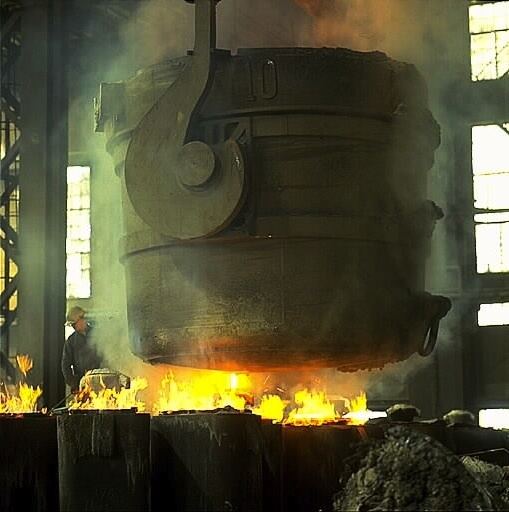 | ||
Ductile iron, also known as ductile cast iron, nodular cast iron, spheroidal graphite iron, spheroidal graphite cast iron and SG iron, is a type of graphite-rich cast iron discovered in 1943 by Keith Millis. While most varieties of cast iron are brittle, ductile iron has much more impact and fatigue resistance, due to its nodular graphite inclusions.
Contents
On October 25, 1949, Keith Dwight Millis, Albert Paul Gagnebin and Norman Boden Pilling received US patent 2,485,760 on a Cast Ferrous Alloy for ductile iron production via magnesium treatment.
Metallurgy
Ductile iron is not a single material but part of a group of materials which can be produced with a wide range of properties through control of their microstructure. The common defining characteristic of this group of materials is the shape of the graphite. In ductile irons, graphite is in the form of nodules rather than flakes as in grey iron. Whereas sharp graphite flakes create stress concentration points within the metal matrix, rounded nodules inhibit the creation of cracks, thus providing the enhanced ductility that gives the alloy its name. Nodule formation is achieved by adding nodulizing elements, most commonly magnesium (magnesium boils at 1100 °C and iron melts at 1500 °C) and, less often now, cerium (usually in the form of mischmetal). Tellurium has also been used. Yttrium, often a component of mischmetal, has also been studied as a possible nodulizer.
"Austempered Ductile Iron" (ADI) was discovered in the 1950s but was commercialized and achieved success only some years later. In ADI, the metallurgical structure is manipulated through a sophisticated heat treating process. The "aus" portion of the name refers to austenite.
Composition
A typical chemical analysis of this material:
Elements such as copper or tin may be added to increase tensile and yield strength while simultaneously reducing ductility. Improved corrosion resistance can be achieved by replacing 15% to 30% of the iron in the alloy with varying amounts of nickel, copper, or chromium.
Applications
Much of the annual production of ductile iron is in the form of ductile iron pipe, used for water and sewer lines. It competes with polymeric materials such as PVC, HDPE, LDPE and polypropylene, which are all much lighter than steel or ductile iron; being softer and weaker, these require protection from physical damage.
Ductile iron is specifically useful in many automotive components, where strength needs surpass that of aluminum but do not necessarily require steel. Other major industrial applications include off-highway diesel trucks, Class 8 trucks, agricultural tractors, and oil well pumps. In wind power industry nodular cast iron is used for hubs and structural parts like machine frames. Nodular cast iron is suitable for large and complex shapes and high (fatigue) loads.
SG iron is used in many grand piano harps (the iron plates to which high-tension piano strings are attached).
